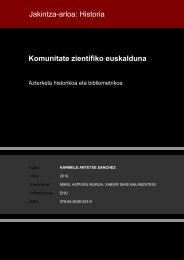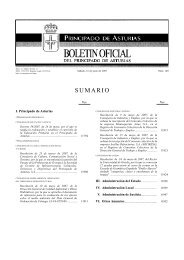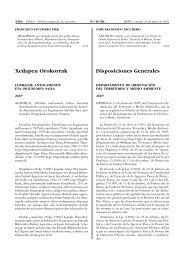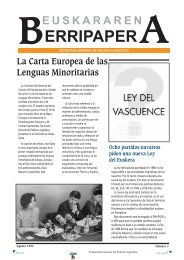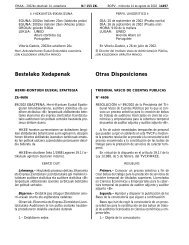MOLUSKUEN LISERI-GURUINEKO EPITELIOAREN ... - Euskara
MOLUSKUEN LISERI-GURUINEKO EPITELIOAREN ... - Euskara
MOLUSKUEN LISERI-GURUINEKO EPITELIOAREN ... - Euskara
You also want an ePaper? Increase the reach of your titles
YUMPU automatically turns print PDFs into web optimized ePapers that Google loves.
Emaitzak eta eztabaida<br />
Reversible cell-type replacement in the digestive gland epithelium of the<br />
marine mollusc Littorina littorea exposed to cadmium<br />
Abstract: Marine winkles Littorina littorea were exposed to 1.25 mg/l Cd for 21 days to provoke the<br />
proliferation of basophilic cells. Then, animals were depurated in clean seawater for 10 days to determine<br />
whether CTR was reversible. Digestive glands were fixed in Carnoy and paraffin embedded for histological<br />
analysis. The volume densities of basophilic cells (Vv BAS ) and digestive cells (Vv DIG ) were calculated by<br />
stereology on haematoxylin-eosin stained sections. Vv BAS raised and Vv DIG decreased in Cd exposed<br />
animals. After estimation of cell size and absolute cell numbers, these changes were attributed to digestive<br />
cell loss and concomitant basophilic cell hypertrophy but not to increased numbers of basophilic cells. The<br />
cell type composition and cell size almost fully returned to normal values after 10 days depuration.<br />
Accordingly, PCNA immunohistochemistry demonstrated that proliferating digestive cells were more<br />
abundant in winkles exposed to Cd and after 10 day depuration than in control specimens, suggesting that<br />
net digestive cell loss was accompanied by increased digestive cell proliferation and that CTR was not<br />
related to any contribution by basophilic cells. Thus, Cd-exposure seems to provoke an enhanced digestive<br />
cell turnover in order to cope with Cd detoxification. Autometallography revealed the presence of black silver<br />
deposits (BSD), most likely formed around Cd ions, in digestive cell lysosomes whereas basophilic cells<br />
appeared devoid of them. After depuration, BSD were less conspicuous. Changes occurring in digestive cell<br />
lysosomes were quantified by automatized image analysis on cryostat sections stained to demonstrate ßglucuronidase<br />
activity. Enlarged lysosomes were observed in Cd-exposed winkles while return to control<br />
levels ocurred after 10 days depuration. Changes in digestive cell proliferation, digestive cell loss and<br />
basophilic cell hypertrophy did not apparantly affect the exposure (BSD) and effect (lysosomal responses)<br />
biomarkers investigated herein.<br />
Key Words cell-type replacement, winkle, cadmium, PCNA, digestive gland, effect and exposure<br />
biomarkers.<br />
140






